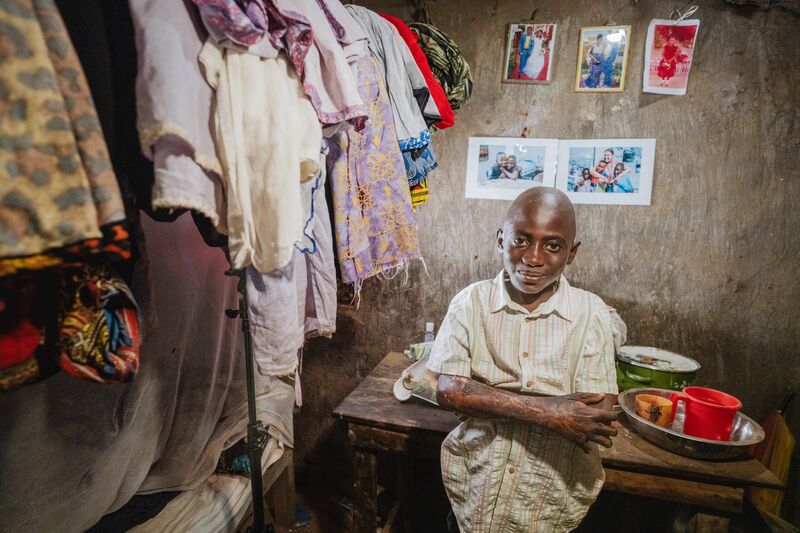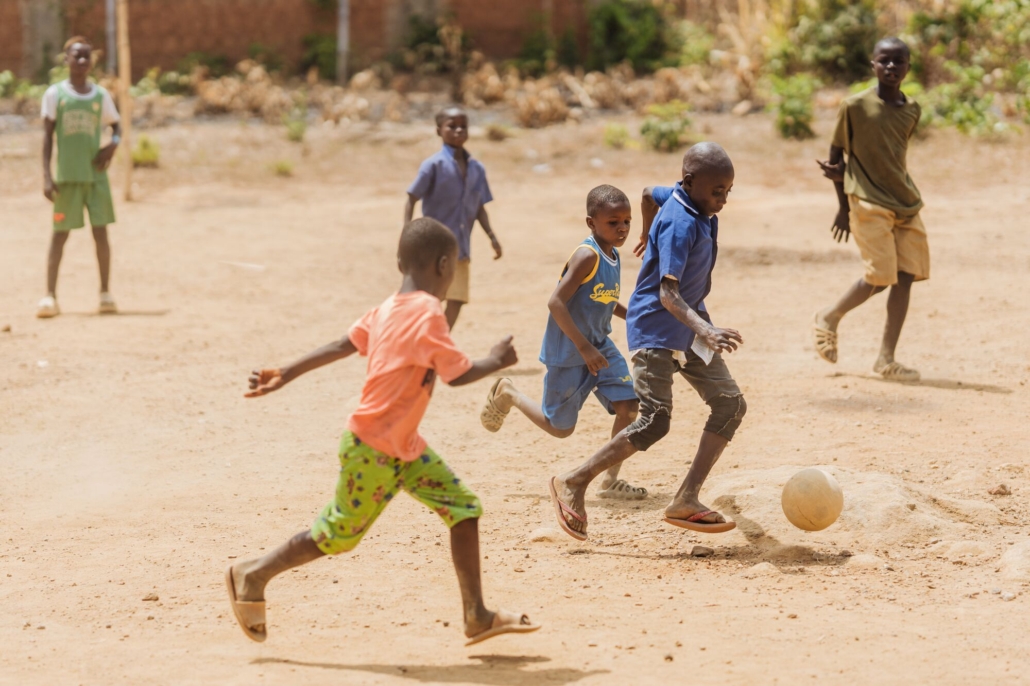“Doctor of the Ward”: David’s Journey with Mercy Ships
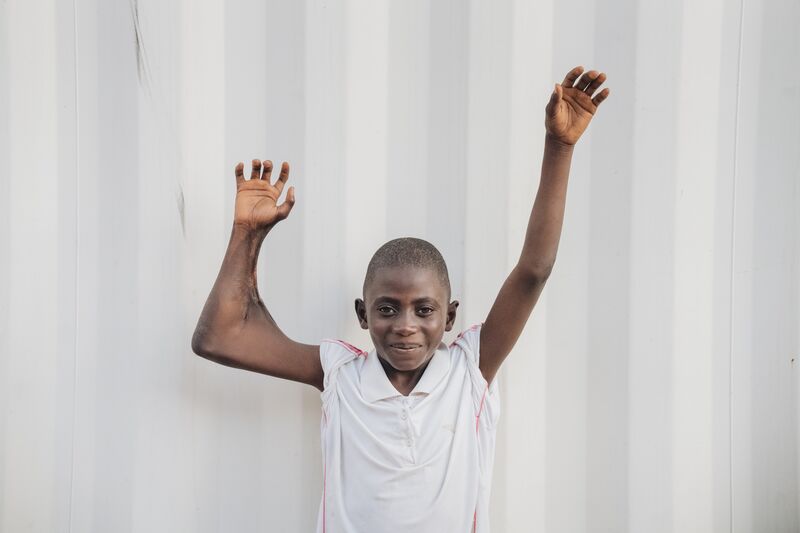
David, plastics patient.
Now 12 years old, David’s journey began in the quiet village of Sama Nywalinga, nestled at the end of a long, dusty road, 120 miles from Sierra Leone’s second-largest town of Bo. His world changed forever when, at just a year old, a boiling pot of water spilled on him in a tragic accident.
The burns scorched his small body, leaving lasting scars etched across his head, forearm, and side. As the wounds healed, his right arm became locked in a permanent bend—burn contractures pulled his skin so tightly that he could no longer straighten it.
But physical pain was only part of David’s struggle. His childhood was overshadowed by his mother’s absence. She left after the accident and the residual silence spoke louder than any words.
“I know who my mom is, but she doesn’t care about me,” he said quietly, believing her absence might be his fault.
School could have been a refuge for a boy with no parental anchor. Instead, it became an uphill battle. The burns he endured left him unable to use his right arm. His scars made him a target for cruel taunts, and he endured relentless bullying from his classmates.
“I do not like going to school,” he admitted. “They call me names like ‘Burnt Hand Boy.’ I don’t like it.”
Shortly after the accident, David was taken to a nearby hospital where he was given ointment for the burn. Years passed with little hope. Nearly a decade later, David’s grandmother took him to the hospital once again, desperate for help. But the doctors could do nothing—his case was too complex for the limited resources available.
That’s when they heard about Mercy Ships.
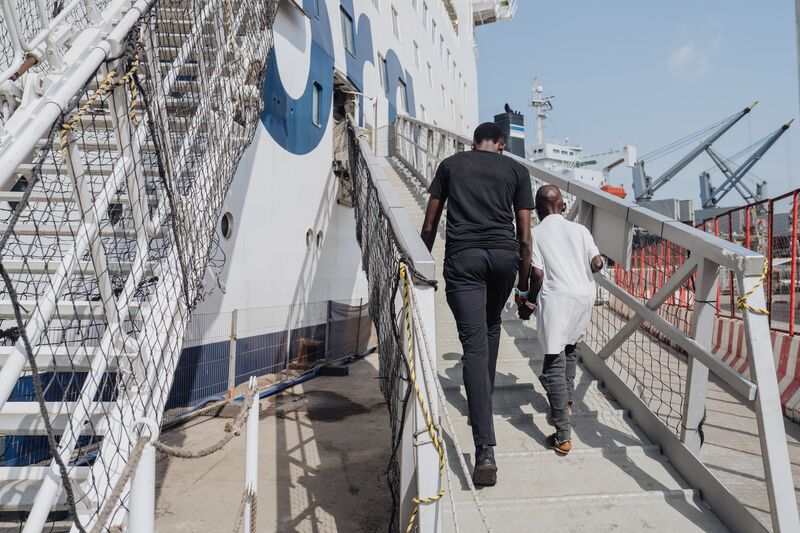
David, arriving at the Global Mercy.
Arriving at Mercy Ships
David and his cousin, Kamanda, traveled for five hours to Freetown, carrying only an overnight bag and faith that David would be healed. They arrived at the Hospital Outpatient Extension (HOPE) Center, a facility used by Mercy Ships to provide a space for patients to prepare for their consultations and surgeries on board the Global Mercy™.
At first, David was quiet, eyes wide as he took in the unfamiliar rhythms of life on a hospital ship filled with doctors and nurses from around the world. It’s not an uncommon reaction. Many patients, especially children, are unsure how to navigate this unique environment. But surrounded by peers and wrapped in care, David began to bloom.
Within days, he wasn’t just another patient. He was known by everyone on board as David, a living spark of energy and joy. He made fast friends, particularly with two other boys named Mathew and Ibrahim. The trio became inseparable.
“They’re like the Three Musketeers,“ the ward nurses would say, watching them parade through the halls, leaving a trail of laughter and lighthearted chaos in their wake.
David’s infectious energy transformed the ward. He became a beacon of joy, waving at passersby from the window, tapping on the glass, eager to make connections. Even non-medical volunteers came to recognize his signature grin and wave.
But what caught everyone’s eye the most was his fascination with the medical team. He followed doctors through the halls, mimicking their every move. He examined fellow child patients, offered mock diagnoses, and checked “charts” with an authority that left everyone smiling.
Just months prior, kids in his village called him “Burnt Hand Boy.” But now, David has earned a new title: “Doctor of the Ward.”Receiving Life-Changing Surgery
Under the skilled hands of Dutch volunteer surgeon Dr. Tjeerd de Jong and Jannietha Kramer, a ward team leader, David underwent the surgery to release the contracture that had held his arm in a painful bend for nearly a decade.
Dr. de Jong has a lot of experience with patients like David. “Many people in low-income countries have cooking and living conditions where there’s open fire and hot water or oil,” he explained. “So, we see many cases where patients get severe burns on their feet or their hands, and primary care for burn patients is not available.”
When burns are left untreated, the damage can be long lasting. “If the patient survives,” he continued, “they will end up with huge wounds. When there’s full skin loss, the wound will go away, the skin will die, and the wound will heal by becoming smaller. So, it will start pulling on the joints close to it. That’s what David had.”
David’s surgery lasted two hours. Though he entered the operating room nervously, he faced it as he faced everything—with quiet bravery.
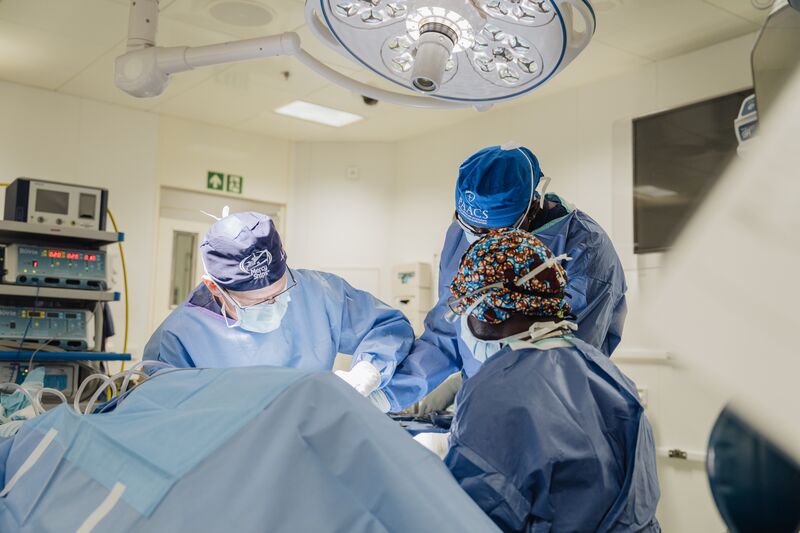
Dr. Tjeerd de Jong, Reconstructive Plastic Surgeon, Dr Toko Wils Plastic Reconstructive Surgeon and PAACS Resident, and Dr. Eric Wongo, Plastic Reconstructive Surgeon, during David’s surgery.
Receiving Life-Changing Surgery
Under the skilled hands of Dutch volunteer surgeon Dr. Tjeerd de Jong and Jannietha Kramer, a ward team leader, David underwent the surgery to release the contracture that had held his arm in a painful bend for nearly a decade.
Dr. de Jong has a lot of experience with patients like David. “Many people in low-income countries have cooking and living conditions where there’s open fire and hot water or oil,” he explained. “So, we see many cases where patients get severe burns on their feet or their hands, and primary care for burn patients is not available.”
When burns are left untreated, the damage can be long lasting. “If the patient survives,” he continued, “they will end up with huge wounds. When there’s full skin loss, the wound will go away, the skin will die, and the wound will heal by becoming smaller. So, it will start pulling on the joints close to it. That’s what David had.”
David’s surgery lasted two hours. Though he entered the operating room nervously, he faced it as he faced everything—with quiet bravery.
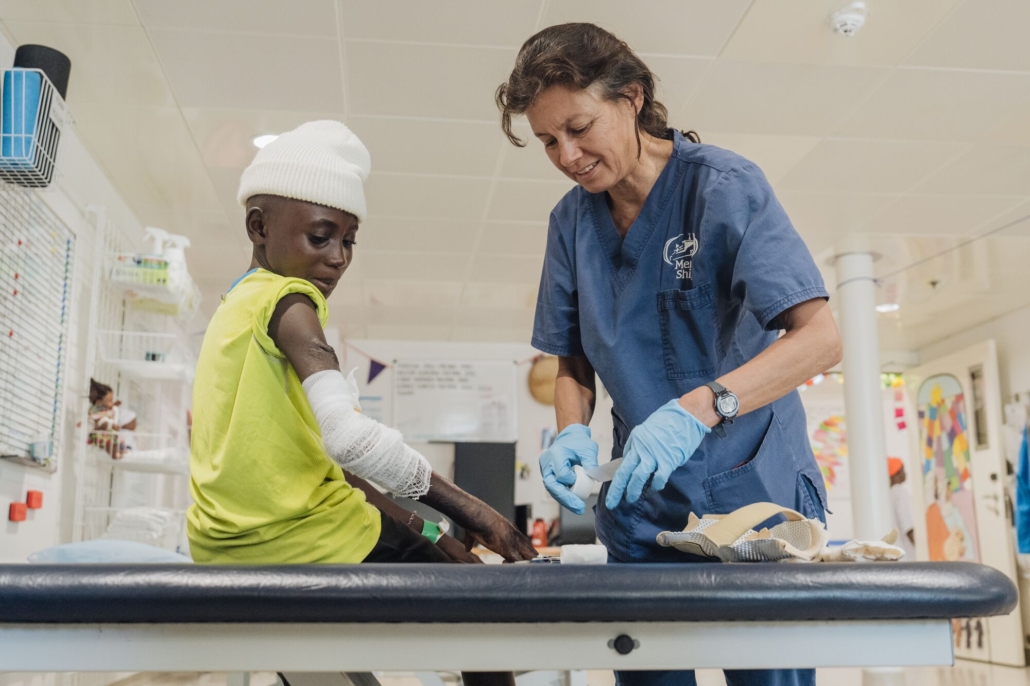
Clare Kiamtia, Hand Therapist, working with David, during a rehab session.
A Challenging Rehabilitation Met With Resilience
David’s road to recovery was anything but smooth. An unexpected infection forced him into isolation, cutting him off from the joy he once found in the wards. His spirit sank; he missed his friends and family.
His growing body pulled on the healing scars, making every exercise a painful battle. Continued growth complicated treatment, which led to repeated surgeries.
For patients like David, physical therapy is grueling—physically and emotionally. Regaining mobility through stretching and strengthening exercises often means months working against painful scar tissue. Progress is fragile; setbacks like infections or failed grafts are common. Without this daily exercise, the scar tissue would pull his skin tightly again, restricting movement.
“Scar tissue usually takes one to one and a half years to settle,” explained Dr. de Jong. “Early on, the scars will be very active before slowly softening and fading over time. With months of exercise and healing, David will regain even more function.”
Despite the soreness from surgery and his heavily bandaged arm, David smiled through it all.
Back in the ward, David’s spirit was magnetic. He became a caregiver in training; an ever-curious boy with dreams of becoming a doctor. He reunited with the friends and nurses he had grown to love, including Mathew and Ibrahim. Laughter filled the hallways; a testament to resilience and shared joy on board.
In countries like Sierra Leone, post-surgical rehabilitation is still rare. However, partnerships between Mercy Ships and the Ministry of Health are working to change that.
“Even when rehab is available, it’s often limited to short periods,” explained Clare Kiamtia, a volunteer hand therapist from New Zealand. ” Mercy Ships offers extended rehabilitation, enables patients to reach a good level of function, and we can often follow up on previous patient progress.”
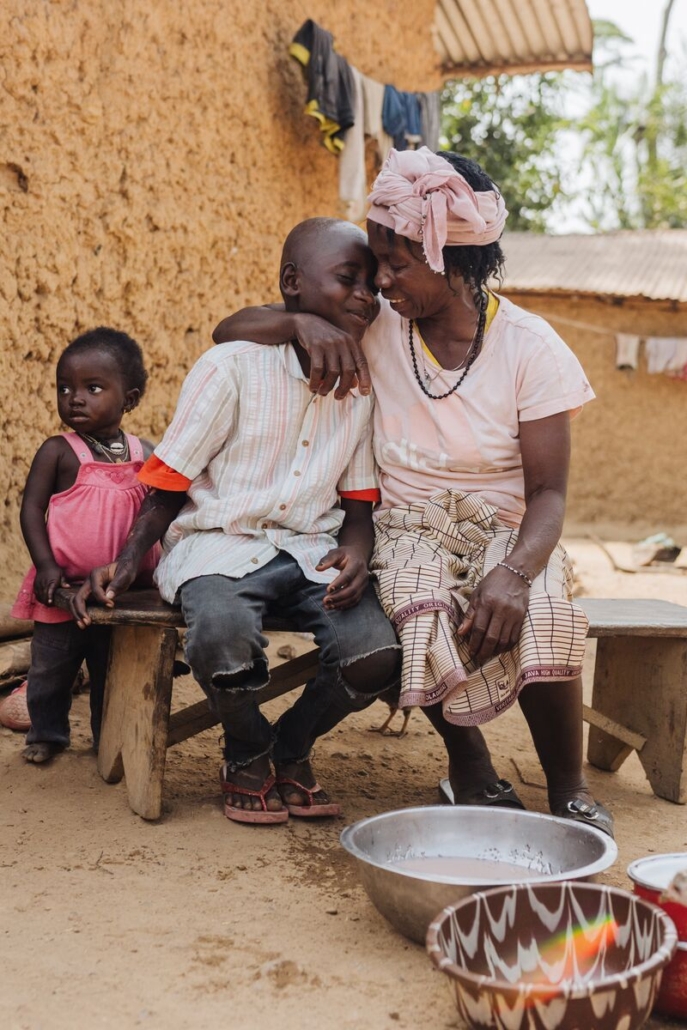
David, at his home during a home visit after his surgery on the GLM.
David’s Return Home
The villages outside of Bo are surrounded by lush greenery, with dirt roads winding through rolling farmland and dense palm groves. Life moves to the rhythms of farming, trading, and neighborly laughter, punctuated by the distant hum of passing motorbikes.
As the Mercy Ships truck pulled into the village of Sama, curious faces gathered as David had not been seen here since leaving for the ship. David’s grandmother was the first to reach him, wrapping him in a fierce, loving hug. Neighbors marveled all around them at his transformation.
Inside her small mud-brick home, David helped his grandmother prepare food — triumphantly cooking beside the same fire that had once caused his injuries. It was a full-circle moment of healing.
“I was happy for him and was praying for a successful surgery,” his grandmother said. “And today, I am so glad to see David [again].”
In the dim, crowded classroom of his old school, David reunited with his classmates. Together, they recited the days of the week in proud chorus.
“I was so happy to see David return, healthy and strong,” said his teacher, Ansu. “Today, he raised his hand in class; something he couldn’t do before. We thank God for this miracle.”
David’s return to the village provided a sense of closure for himself and an opportunity to show the community he grew up in just how much he overcame.
“We can never predict the future of children,” said village Chief, Mustafa Kombe. “When David got injured, we never even expected someone to come to help heal his hand. Thank you, Mercy Ships, and we pray for blessings on your work!”
Mercy Ships relies on volunteers and donors to continue transformative surgeries that change lives like David’s. Will you help bring hope and healing to those who need it most? Learn more at mercyships.org.

